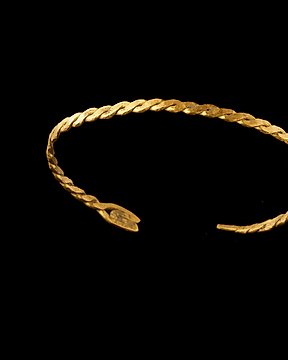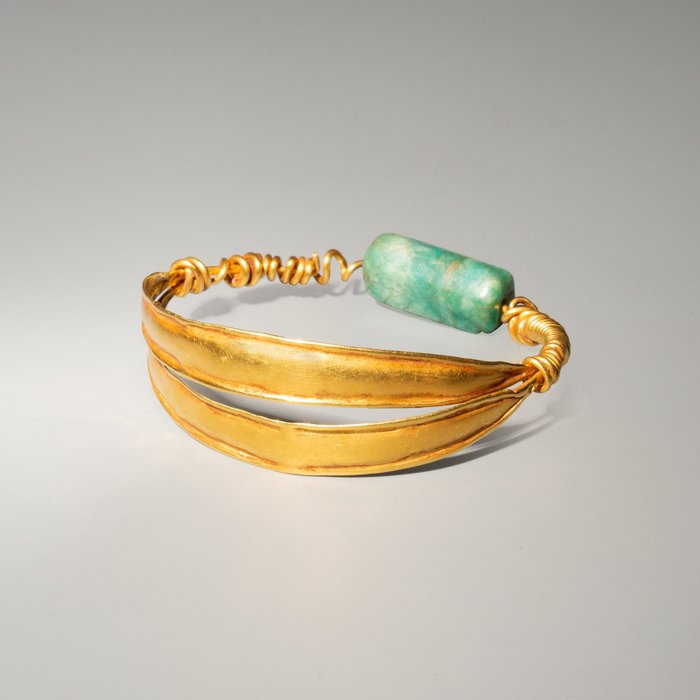
Roma Antiga Ouro Pulseira, século I - III dC. Largura 4,8 cm. 4,26 gr.
N.º 81269191

N.º 81269191

Bracelet.
- Intact! -
- High Quality! -
Ancient Rome, 1st - 3rd century AD.
MATERIAL: Gold and stone.
SIZE: Width 6.6 cm, height 6 cm and inner diameter 5.5 cm. Gross weight: 27.7 gr.
PROVENANCE: - Private collection, Paris, 1970.
CONDITION: Intact, in perfect state of preservation.
BIBLIOGRAPHY:
- EDMONSON, J. C.; KEITH, A. (eds.). Roman Dress and the Fabrics of Roman Culture. University of Toronto Press. 2008.
- MARSHALL, F. H. Jewellery. Catalogue of the Jewellery, Greek, Etruscan, and Roman, in the Departments of Antiquities, British Museum. British Museum Publications. 1911.
- OGDEN, J. Ancient Jewellery. British Museum Press. 1992.
- OLSON, K. Dress and the Roman Woman: Self-Presentation and Society. Routledge. 2008.
- VV.AA. Jewellery through 7000 years. British Museum Publications Ltd. 1976.
PARALLELS:
Fig. 1 Gilt bronze bracelet. Late Roman, 3rd-8th centuries AD. British Museum, London, inv. EA53935.
Fig. 2 Gold bracelet. Roman, 3rd-4th centuries AD. Metropolitan Museum, New York, inv. 17,192,258.
Fig. 3 Gold filigree and emerald earrings. Romans, 2nd-3rd centuries AD. Particular collection.
Fig. 4 Gold necklace. Roman, 3rd-4th centuries AD. Sotheby's New York, December 12, 2014, lot 15.
Fig. 5 Gold bracelet. Roman, 3rd century AD. Victoria & Albert Museum, London, inv. M.15-1966.
DESCRIPTION:
Solid gold Roman bracelet with a rigid ring, worked using forging and filigree, two traditional techniques, both constructive and decorative, used since ancient times but also very frequent in Roman jewelry. The piece under study is built from gold threads, which are bent or forged to form the different parts of the bracelet. A similar way of working the filigree can be found on a fragmentary bracelet in the British Museum (fig. 1). In one of the halves of the piece under study, it can be seen how, from two thick rods, two parallel bands are shaped, with incised and slightly convex profiles on their surface. At the opposite end of the bracelet, filigree threads are twisted into a gimp that is finally stretched to hold the stone. In this area, therefore, the filigree thread is double: inside the wound are the ends of the rods that form the bands on the opposite side. This filigree set, therefore, not only decorates but also adds solidity to the bracelet. The same is true of pieces such as the twisted bracelet in the Metropolitan Museum (fig. 2).
In contrast to the gold, in the center of the other half of the piece, there is a carved and polished hard stone, almost cylindrical in shape and bluish tones, whose ocher veins balance perfectly with the warm tone of the metal . This stone is not fixed but can rotate, as if it were an ancient cylinder-seal from the Mesopotamian world. This same way of incorporating stones into jewelry can be found in other types of pieces, such as earrings from a private collection (fig. 3) or an Egyptian necklace from Roman times sold in 2014 (fig. 4).
The world of jewelry since ancient times has been linked to a certain status. Both men and women liked to surround themselves with luxury and make use of precious materials. However, while men introduced it into their general life, such as decorating their houses, women were the only ones who wore ornaments, with the exception of a ring in the case of men.
Roman jewelry reached a development never seen before and was not surpassed until the Renaissance. Imperial Rome was the world center of jewelry, importing large quantities of precious stones and materials.
The initial style of his works was typically Greek or Etruscan, but he soon developed his own style, ornate and ostentatious, precious stone settings, opus interassile, true mosaic of small stones on a gold or silver support. Another specialty of Roman jewelery was the carving of gems, with its coveted cuts, incisions and bas-reliefs and above all its cameos, carved on agate and onyx, stones with layers of different colors that, once polished, produced an effect of depth and depth. polychromy. His main subjects were portraits.
Notes:
- The piece includes authenticity certificate.
- The piece includes Spanish Export License (Passport for European Union) - If the piece is destined outside the European Union a substitution of the export permit should be requested, can take between 1-2 weeks maximum.
- The seller guarantees that he acquired this piece according to all national and international laws related to the ownership of cultural property. Provenance statement seen by Catawiki.
#pioneeringwomen
#ExclusiveCabinetofCuriosities
Como comprar na Catawiki
1. Descubra algo especial
2. Faça a licitação vencedora
3. Faça um pagamento seguro